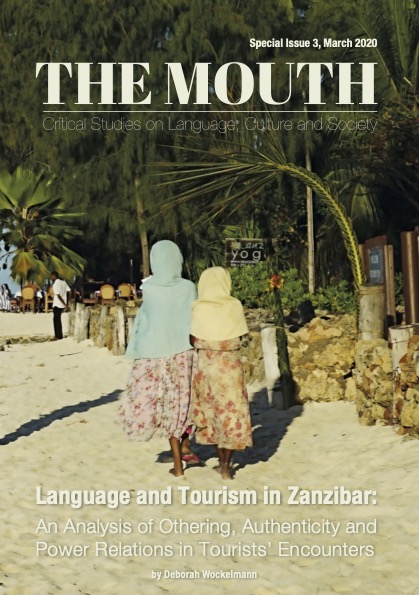Language and Tourism in Zanzibar: An Analysis of Othering, Authenticity and Power Relations in Tourists’ Encounters
DOI:
https://doi.org/10.18716/ojs/the_mouth.3170Abstract
The dynamics of tourism reach into various spheres of life, and offer space for powerful societal transformation, multicultural exchange, for connections and likewise for demarcations between peoples. Tourism in Southern spheres does not only influence the Global South in terms of financial resources, but also brings about change in societies, landscapes and languages. In East Africa, Zanzibar depicts one of the most impressive tourist hotspots on the Indian Ocean. It is known predominantly for its multi-layered cultural‒historic formations and is highly regarded within the global tourism industry for its World Heritage Site of Stone Town as well as its coastal landscapes. The cultural diversity of Zanzibar is closely related to its linguistic diversity, which is heavily influenced by the flow of mass tourism. Because language not only fulfils a universal role as a pragmatic means of interaction but is also one of the most decisive markers of belonging used by human beings, it is one of the main pillars that helps mould tourism. It can not only denote internationality but also indicates bonds and boundaries between individuals. Language enables tourists in Zanzibar to communicate and get along with locals no matter which part of the world they come from. At the same time language, as a primary characteristic of human culture, reveals unwritten laws and traces of global history. Since this research is engaged with the interplay of tourism and language, language use in Zanzibari tourism raises some fundamental questions such as: Which role does language play in tourism?, Are tourists concerned with local languages, and if they are what are their intentions in learning them and their means to do so?, What do linguistic competence and language choice reveal about speakers and individuals who interact?

Downloads
Published
Issue
Section
License

This work is licensed under a Creative Commons Attribution 4.0 International License.
CC BY 4.0 deed
https://creativecommons.org/licenses/by/4.0/deed.en
You are free to:
- Share — copy and redistribute the material in any medium or format for any purpose, even commercially.
- Adapt — remix, transform, and build upon the material for any purpose, even commercially.
- The licensor cannot revoke these freedoms as long as you follow the license terms.
Under the following terms:
- Attribution — You must give appropriate credit , provide a link to the license, and indicate if changes were made . You may do so in any reasonable manner, but not in any way that suggests the licensor endorses you or your use.
- No additional restrictions — You may not apply legal terms or technological measures that legally restrict others from doing anything the license permits.
Notices:
You do not have to comply with the license for elements of the material in the public domain or where your use is permitted by an applicable exception or limitation .
No warranties are given. The license may not give you all of the permissions necessary for your intended use. For example, other rights such as publicity, privacy, or moral rights may limit how you use the material.Notice
This deed highlights only some of the key features and terms of the actual license. It is not a license and has no legal value. You should carefully review all of the terms and conditions of the actual license before using the licensed material.
Creative Commons is not a law firm and does not provide legal services. Distributing, displaying, or linking to this deed or the license that it summarizes does not create a lawyer-client or any other relationship.
Creative Commons is the nonprofit behind the open licenses and other legal tools that allow creators to share their work. Our legal tools are free to use.





